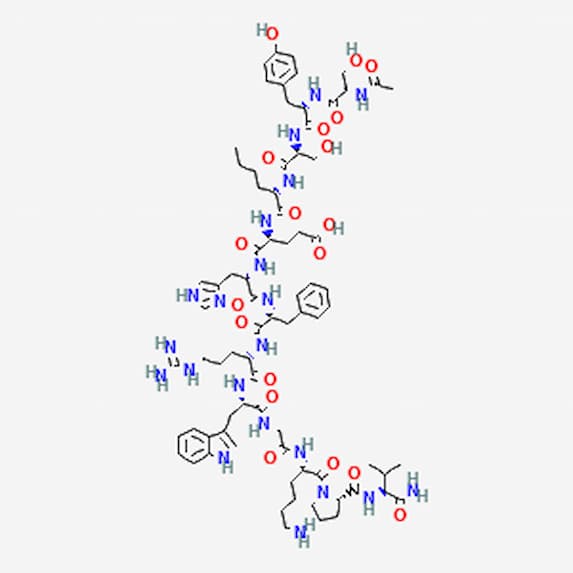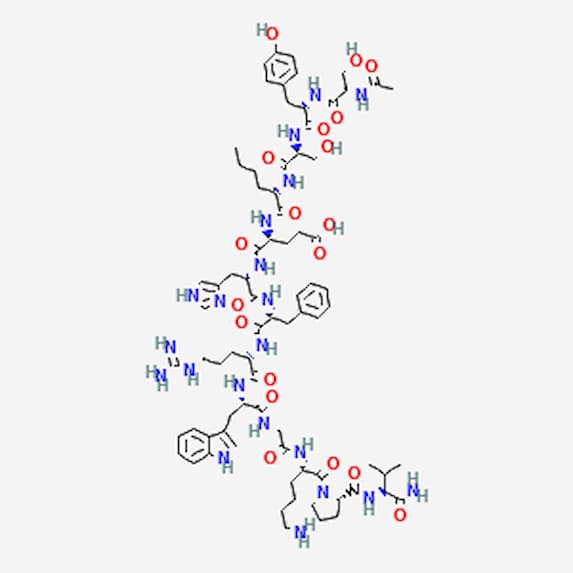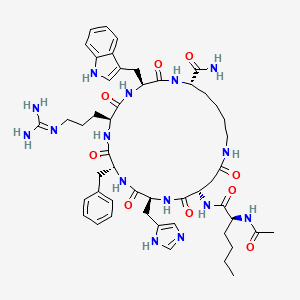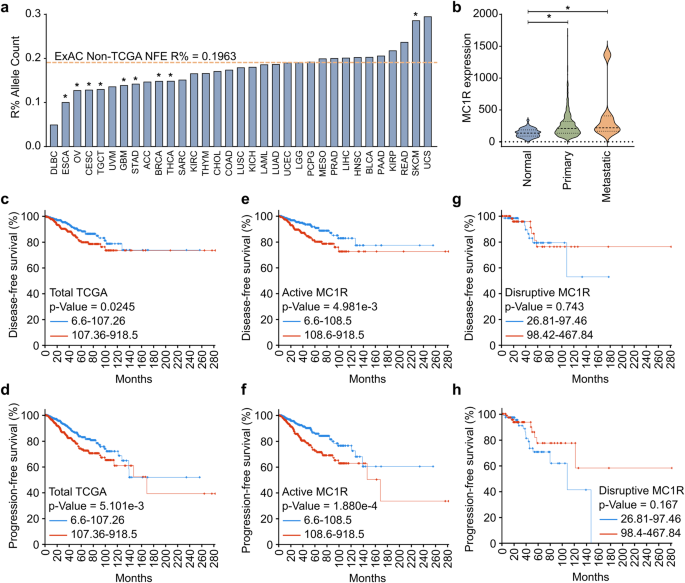Melanotan 1 vs Melanotan 2
There are some major differences between Melanotan 1 and Melanotan 2. Learn the differences between Melanotan 1 physiology and Melanotan 2 below.

www.peptidesciences.com
Melanotan 1 (MT1) and its counterpart
melanotan 2 (MT2) are synthetic derivatives of alpha-melanocyte stimulating hormone (a-MSH). Both peptides bind to melanocortin receptors to produce a variety of interesting effects. Of note, both MT1 and MT2 have an impact on melanin expression and thus skin pigmentation. Both also affect sexual arousal, feeding behavior, blood pressure, central nervous system function, and willpower. Given that they are so similar in terms of function, it should come as no surprise that searches for melanotan 1 vs 2 are exceptionally common. Below is a look at how these peptides stack up against one another because even though they are similar in many ways there are also a host of differences in melanotan 1 vs 2.
Structure of Melanotan 1 vs 2
Amino Acid Sequence: SYSXEHFRWGKPV
Molecular Weight: 1646.8 g/mol
Molecular Formula: C78H111N21O19
Synonyms: Afamelanotide, SCENESSE
Source:
PubChem
Amino Acid Sequence: Nle-DHRFWK
Molecular Weight: 1024.2 g/mol
Molecular Formula: C50H69N15O9
Synonyms: Bremelanotide (slight modification)
Source:
PubChem
It should be fairly obvious from the images that MT1 and MT2 are very different molecules. MT1 is much more similar to a-MSH than MT2, which is why it retains more of the parent molecules’ properties, particularly in relation to pigmentation. Their slight differences in structure result in melanotan 1 having different receptor binding affinities than melanotan 2. Thus, even though both melanotan 1 and melanotan 2 bind to the same melanocortin receptors, they do so with different strengths. This difference in binding preference alters the overall impact these peptides have.
Melanotan 1 vs 2 Overview
The easiest way to understand the differences and similarities between melanotan 1 vs 2 is to look at their effects side by side. Below is a comparison between general research findings for these two peptides that offers a broad overview of their properties.
Melanotan 1
• Skin pigmentation
• Fat burning
• Cognitive function
• Blood pressure
• Vascular health
• Neuroinflammatory disease
Melanotan 2
• Sexual function (erectile dysfunction)
• Skin pigmentation
• Impulse control
• Addiction behavior
• Hunger and satiety regulation
• Autism Spectrum Disorder
There are clearly similarities in these two molecules if they are looked at from a higher level. Both affect the skin, central nervous system, and certain aspects of metabolism. Closer inspection reveals that there are nuances within these categories that distinguish melanotan 1 vs 2. These nuances are likely due to specific patterns of receptor binding and will hopefully help researchers to better understand how subtle differences in binding affinities for multiple receptors can fine-tune an entire system. In other words, melanotan 1 vs 2 differences have helped to expand upon the simple on/off dichotomy of early biological thinking. Individual receptors may simply be turned on or off, but entire systems can be gently tuned by turning on or off different numbers of receptors and different types of receptors to produce a spectrum of emergent effects.
Receptor Binding of Melanotan 1 vs 2
Melanotan 1 and melanotan 2 are relatively non-specific agonists of multiple melanocortin receptors. Both peptides bind to melanocortin receptors throughout the body and both have varying levels of affinity for MC1R (melanocortin 1 receptor), MC3R, MC4R, and MC5R. Of note, neither seems to have much affinity for MC2, which primarily affects the secretion of hormones from the adrenal glands.
What really sets melanotan 1 vs 2 apart is the fact that MT2 has a heighted affinity for the MC4 receptor while melanocortin 1 retains a-MSH’s enhanced affinity for MC1R. This means that melanotan 1 has stronger pigmentation effects while melanotan 2 has stronger sexual effects including impacts on erectile function and sexual arousal.
Of course, the differences between melanotan 1 vs 2 go deeper than just their primary receptor interactions. Melanotan 1, for instance, has significant effects at the MC5 receptor, which is found on pancreatic islet cells. Research shows that MC5R stimulation promotes fatty acid metabolism and may help to aid in weight loss[1]. Melanotan 2, on the other hand, demonstrates significant effects on the MC3 receptor. While little is known about the MC3 receptor, there is speculation that it may be involved in certain autism spectrum disorder behaviors. And, indeed, research on MT2 suggests that it can help to overcome the decreased communication, repetitive behaviors, and impaired social interactions seen in autism[2].
The melanocortin receptor signaling system is not well understood and, in fact, was almost entirely unknown to science prior to the development of melanocortin 1. This is an excellent example of how a seemingly simple discovery can open the door to increased understanding of the fundamentals of human physiology. With continued work, the dichotomy of melanotan 1 vs 2 is helping scientists to probe the nuances of the melanocortin system to better understand the role of these receptors in our biological function.
Melanotan 1 vs 2: Research and Development
Melanotan 1 and 2 have followed very different research pathways. Whereas MT1 was originally developed as a sunless tanning agent and then abandoned for years, MT2 was studied as a drug candidate for female hypoactive sexual desire disorder and male erectile dysfunction. These differences in research pathways are reflective of the peptides’ different melanocortin receptor binding affinities.
Despite the fact that MT1 was initially abandoned early in research circles, the peptide has experienced something of a resurgence of interest in recent years. Melanotan 1 was originally developed at the University of Arizona where it was shown to boost pigmentation by as much 75% and decrease the risk of sunburn by as much as 47%. Developers originally thought that these features would make MT1 useful in protecting people against the long-term effects of ultraviolet skin damage[3]. This particular use of melanotan 1 did not pan out for a variety of reasons leading to near complete abandonment of the peptide for research purposes.
Melanotan 2 was, in various forms, developed for the treatment of various sexual dysfunctions including female hypoactive sexual desire disorder and erectile dysfunction under the name bremelanotide. This research was also abandoned in part because of clinical trial design problems, but mostly because of a serious patent dispute between Competitive Technologies and Palatin Technologies.
Competitive Technologies is a technology transfer company that operates in conjunction with the University of Arizona. In 2006, it licensed use of melanotan 1 to an Australian startup called Clinuvel looking to develop the peptide as a sunless tanning agent. At the same time, Palatin Technologies, which had secured licensing rights to MT2, was developing a derivative known as bremelanotide. Bremelanotide differs from MT2 in that it has a hydroxyl group rather than an amide group.
Competitive Technologies sued Palatin for breach of contract, claiming ownership of bremelanotide, which was thought to be a metabolite of MT2. Eventually the lawsuit was settled and Palatin retained the rights to bremelanotide while Competitive Technologies was paid US $800,000. This lawsuit is important because it established that the original clinical trial benefits of MT2 were likely due to the presence of its slightly different metabolite bremelanotide. This reignited interest in both Melanotan 1 and 2 as it became obvious that many of the original issues that led to research abandonment could be overcome with simple modifications to the peptides.
MT1, under the generic name afamelanotide and the brand name SENESSE, has be approved for the treatment of adults with erythropoietic protoporphyria in Europe, Australia, and the United States. Under Clinuvel’s guidance, MT1 has undergone 15 clinical trials involving over 900 patients and resulting in more than 200 journal articles[4]. It is currently being tested for several other indications including other forms of porphyria, vitiligo, xeroderma pigmentosa, arterial ischemic stroke, and in pediatric patients. According to Dr. Philippe Wolgen, the CEO of Clinuvel, first treatment of patients with MT1 took place in April 2020.
A Summary of Melanotan 1 vs 2
In the end, melanotan 1 and 2 are very different molecules on a structural level yet they have very similar properties on a functional level. This revelation has helped to move the science of peptides forward by demonstrating that minor changes to the structure of a peptide can have profound influences on both effects and side effects. The argument isn’t really which is better between melanotan 1 vs 2, but rather which is best suited to a given situation. Better is a pejorative term that connotes absolute ranking. In the research world, however, subtlety rules and the differences between melanotan 1 vs 2 should be viewed not in the sense of better vs worse, but in the framework of the varied applications to which these two peptides can be applied. With renewed interest in melanotan 1 vs 2 research, there are bound to be interesting applications of these peptides and modified derivatives of them in the near future.
Resources
[1]C. L. Møller et al., “Characterization of murine melanocortin receptors mediating adipocyte lipolysis and examination of signalling pathways involved,” Mol. Cell. Endocrinol., vol. 341, no. 1–2, pp. 9–17, Jul. 2011, doi: 10.1016/j.mce.2011.03.010.
[2]E. Minakova et al., “Melanotan-II reverses autistic features in a maternal immune activation mouse model of autism,” PloS One, vol. 14, no. 1, p. e0210389, 2019, doi: 10.1371/journal.pone.0210389.
[3]R. T. Dorr et al., “Effects of a superpotent melanotropic peptide in combination with solar UV radiation on tanning of the skin in human volunteers,” Arch. Dermatol., vol. 140, no. 7, pp. 827–835, Jul. 2004, doi: 10.1001/archderm.140.7.827.
[4]“Pharmaceutical Technology,” Clinuvel. https://www.clinuvel.com/pharmaceutical-technology... (accessed Apr. 10, 2022).









